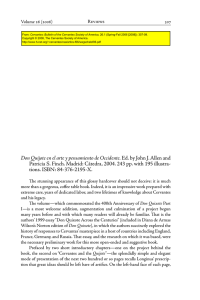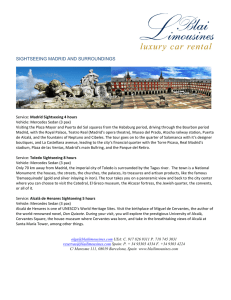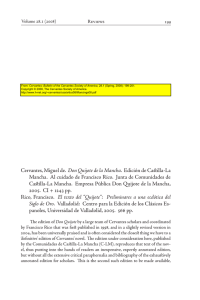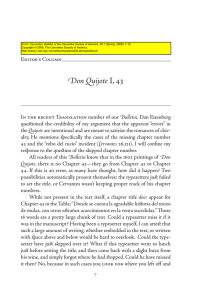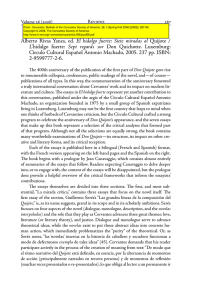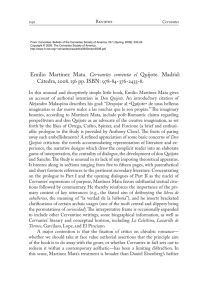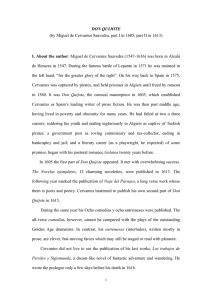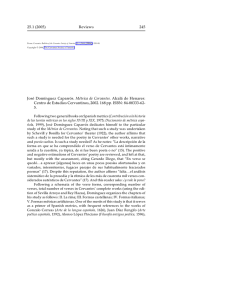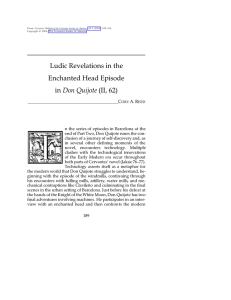Review of a book by Mercedes Alcalá Galán: Escritura desatada
Anuncio
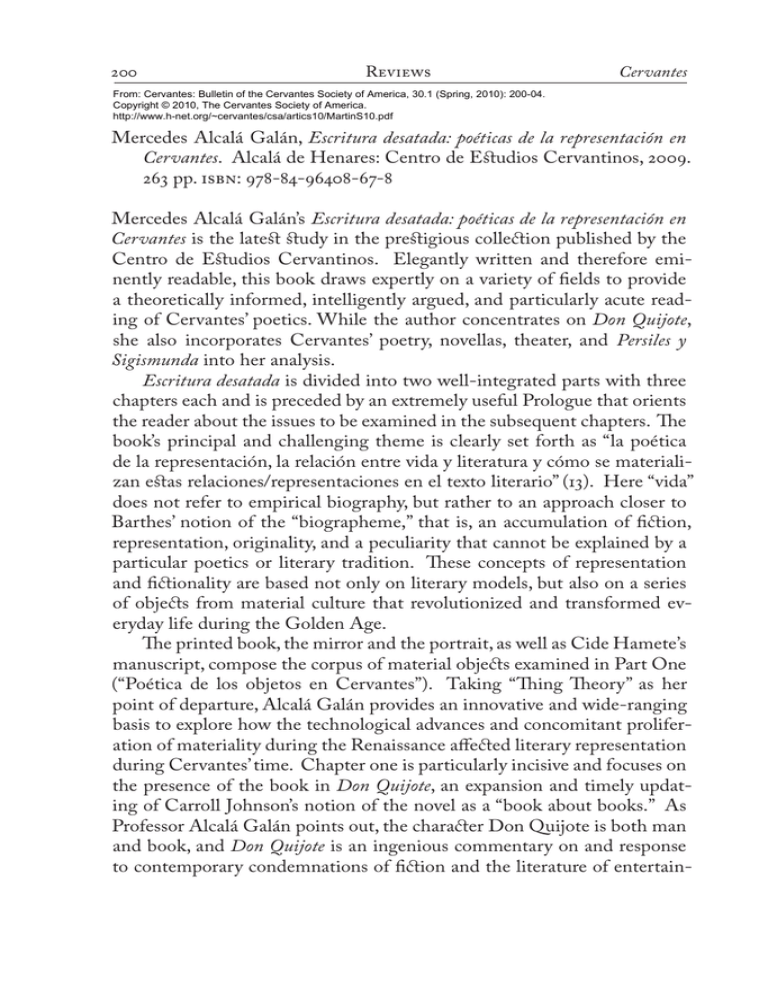
200 Reviews Cervantes From: Cervantes: Bulletin of the Cervantes Society of America, 30.1 (Spring, 2010): 200-04. Copyright © 2010, The Cervantes Society of America. http://www.h-net.org/~cervantes/csa/artics10/MartinS10.pdf Mercedes Alcalá Galán, Escritura desatada: poéticas de la representación en Cervantes. Alcalá de Henares: Centro de Estudios Cervantinos, 2009. 263 pp. isbn: 978-84-96408-67-8 Mercedes Alcalá Galán’s Escritura desatada: poéticas de la representación en Cervantes is the latest study in the prestigious collection published by the Centro de Estudios Cervantinos. Elegantly written and therefore eminently readable, this book draws expertly on a variety of fields to provide a theoretically informed, intelligently argued, and particularly acute reading of Cervantes’ poetics. While the author concentrates on Don Quijote, she also incorporates Cervantes’ poetry, novellas, theater, and Persiles y Sigismunda into her analysis. Escritura desatada is divided into two well-integrated parts with three chapters each and is preceded by an extremely useful Prologue that orients the reader about the issues to be examined in the subsequent chapters. The book’s principal and challenging theme is clearly set forth as “la poética de la representación, la relación entre vida y literatura y cómo se materializan estas relaciones/representaciones en el texto literario” (13). Here “vida” does not refer to empirical biography, but rather to an approach closer to Barthes’ notion of the “biographeme,” that is, an accumulation of fiction, representation, originality, and a peculiarity that cannot be explained by a particular poetics or literary tradition. These concepts of representation and fictionality are based not only on literary models, but also on a series of objects from material culture that revolutionized and transformed everyday life during the Golden Age. The printed book, the mirror and the portrait, as well as Cide Hamete’s manuscript, compose the corpus of material objects examined in Part One (“Poética de los objetos en Cervantes”). Taking “Thing Theory” as her point of departure, Alcalá Galán provides an innovative and wide-ranging basis to explore how the technological advances and concomitant proliferation of materiality during the Renaissance affected literary representation during Cervantes’ time. Chapter one is particularly incisive and focuses on the presence of the book in Don Quijote, an expansion and timely updating of Carroll Johnson’s notion of the novel as a “book about books.” As Professor Alcalá Galán points out, the character Don Quijote is both man and book, and Don Quijote is an ingenious commentary on and response to contemporary condemnations of fiction and the literature of entertain- Volume 30.1 (2010) Reviews 201 ment. Because Don Quijote itself is a book of entertainment, the novel “se embarca en una absurda y brillante condena de sí mismo” ultimately to vindicate fiction “como legítimo instrumento de ocio y como medio ideal para ejercer la más exigente experimentación artística” (43). This chapter weaves together a series of historically textualized topics that explore the effects produced on readers and on society in general by the printing press. The latter’s enabling of the proliferation of non-didactic fiction, the author avers, creates a series of political anxieties that Cervantes fictionalizes and subverts by writing “un libro de ficciones sin complejos, sin referencias eruditas, sin moralina y sin pedir perdón” (57). Escritura desatada analyzes with great specificity fiction’s impact, the attempts to control access to books exercised by moralists and pertinent authorities, literacy rates, and reading practices. It also explores the notion of reading as “possession of a book” and thereby a greater danger since readers cannot forget what they have read (a related topic is taken up in a later chapter on the consequences of reading, as opposed to representing, dramatic texts). Another societal hazard that Alcalá Galán scrutinizes is the notion of contagion produced by the massive reproduction of fiction books post-printing press, linking it to attitudes and fears connected with syphilis in the sixteenth century: “la imprenta va a compartir con el mal de bubas el concepto de contagio, de plaga adquirida mediante el contacto con la cultura impresa y con la infección de las ideas” (66). Given the above, Don Quijote is shown to be a profound commentary on the fears associated with the accessibility of fiction books to “inappropriate” readers such as the uneducated, the morally suspect (Moriscos), Amerindians, and women. As such, this chapter contributes a great deal to current scholarship on the history of the book and of reading practices. Chapter two discusses how the newly accessible small mirror and the portrait change the ways in which humans conceive their subjectivity, how they see and represent themselves. With respect to Don Quijote, the notion of reflection, the tension between how the characters see themselves as opposed to how others see them, is inherent to the novel’s poetics. As we know, the second part of the novel is a reflection of the first part, and the theme of reflection becomes a recurring element which culminates in the Knight of the Mirrors. Similarly, Alcalá Galán contends, the multiple images of Auristela presented in the Persiles become “una especie de dispositivo que permitirá la ubicuidad y la multiplicación de la persona mediante sus copias, a las que se le confieren y transmiten los mismos poderes 202 Reviews Cervantes de seducción y atracción irresistible que a su modelo” (98). This fascinating chapter braids the history of material portraits and representation, their metaphorical use, and their significance to the novel without skipping a hermeneutical beat. Chapter three, focused on Cide Hamete’s manuscript, is an ingenious mapping of the languages of Don Quijote, and a remapping of the ample scholarship on the topic. Alcalá Galán argues that because the original manuscript of Don Quijote—the foundational mother text as it were—was supposedly written in Arabic (a prohibited language from 1566 on) and purportedly translated by a bilingual Morisco, the resulting novel would inevitably be a clandestine book. Her purpose is thus to “explorar el sentido que toma desde un punto de vista histórico la lengua árabe para la comunidad Cristiana y para la morisca a lo largo del siglo XVI para que se entienda mejor el calado real de la ‘broma’ cervantina” (116). This chapter, coherently bolstered by an abundance of critical notes, provides the historical background of the various measures undertaken in the sixteenth century to eliminate the use of Arabic, a prohibition of tremendous consequence for the Morisco population: “El árabe se convierte en lengua subversiva, en forma de resistencia, en lengua sagrada, en prueba de la apostasía de aquellos que lo usan” (120). As she does with respect to hybridity and cultural resistance in Moorish Spain (122-131), Alcalá Galán consistently carries her arguments to their logical conclusions. Her judicious and intelligent use of a variety of critical sources includes the role of translation, and she points out the historical impossibility of Cide Hamete Benengeli’s existence based on the situation of the Moriscos. In this fashion Don Quijote becomes a self-referential form of resistance that, as a book, affects its virtual readers. Part Two of Escritura desatada (“El taller del texto: la literatura como proceso”) is an erudite meditation on literature as process, and the nature of literariness, which is perfectly feasible in terms of what Alcalá Galán argues in the first part. Her treatment of the foundational and unending issue of literary criticism in Don Quijote is particularly significant. Her view is holistic, and her argumentation is well-articulated and persuasive. In chapter four, for example, she takes issue with the standard and rather shopworn interpretations of the much-quoted episode in the novel in which Don Quijote, the priest and the canon discuss the romances of chivalry. Most critics have attempted to attribute (or refute the attribution of ) the canon’s ideas to Cervantes, but Alcalá Galán repudiates that academic Volume 30.1 (2010) Reviews 203 obsession with proving which character supposedly reflects Cervantes’ opinions as inconsistent with his literary practices. Cervantes’ authentic poetics of the novel is to be found, she says, immediately afterwards when Don Quijote spontaneously invents—in the manner of the escritura desatada of the book’s title—the fantastic story of the Caballero del Lago (I, 50). Cervantes’ novelistic lesson, she maintains, is not a dry critical exercise or lesson in verisimilitude, but rather a defense of the pleasure of the text and of reading. Moreover, she adds, “Este pasaje nos muestra una de las claves de la experiencia lectora: el de la vivencia a través de la lectura” (164). In other words, and along the lines of Vargas Llosa’s introduction to the Real Academia Española’s edition of the novel, Cervantes proposes the beauty of creation, of living through literature, over the sterility of theory. This chapter and the two that follow also serve to further revise Cervantes’ unorthodox melding of literary genres as part of the same creative process, one that is as much a voyage and adventure as is Don Quijote’s journey through La Mancha. Thus, chapter five treats Cervantes’ poetics of quotation and engages diplomatically with the select bibliography on the topic. This study of literary resonance foregrounds context vis-à-vis poetic interpolation to conclude that the poetry Cervantes inserts into his novels does not function as lyric pauses, but rather it dialogues with them and completes their meaning. As with all his literature, Cervantes experiments: “no debe esperarse que Cervantes, al considerarse poeta, lo hiciera en un sentido convencional, absoluto […] en el caso de Cervantes especialmente la cita poética es una práctica de escritura que permite indagar en la misma naturaleza poética” (184, 193). The second part of the chapter focuses on theater and Cervantes’ distancing from the comedia nueva. By publishing his dramatic works Cervantes effectively deconstructs theater and converts it into text, a literary work that invites reflection in a way that ephemeral performance cannot. Alcalá Galán concludes that, “Lo que Cervantes propone al publicar un teatro de casi nulas posibilidades de ser representado en ese momento es subvertir los cimientos de la escritura dramática trazando un puente entre obra y lector y excluyendo casi como si fuera en detrimento de la misma obra el proceso de representación” (205). If the previous chapter finds Alcalá Galán in the middle of contemporary discussions about fiction, truth, and the real, the final chapter of Escritura desatada returns to the purportedly orthodox and conventional Persiles. In tune with the five previous chapters, this one concentrates on the writer’s craft, the warp of the text’s fabric, the underside of the can- 204 Reviews Cervantes vas. What Alcalá Galán subtly achieves is to make her readers aware that Cervantes’ contemporaneity is still an untapped source, particularly if one examines his last novel. She acknowledges that “la consecuencialidad narrativa es mucho más débil que en el Quijote” (218), but tempers that view by recognizing that the Persiles is a “semillero de historias” (215). That being the case, Alcalá Galán concentrates on the issues of verisimilitude (220225) that according to the critical tradition places the Persiles in the company of orthodox novelistic practice. She sees in the later novel a subtle and ambiguous experiment, and although verisimilitude in the Persiles may not respond to a coherent system like in Don Quijote, it is because “se plantea no desde el dogma teórico sino desde el especial diseño de la obra que hace posible que en ella se cuestionen abiertamente asuntos de poética” (227). Like Mercedes Alcalá Galán’s previous scholarship, Escritura desatada: poéticas de la representación en Cervantes is a conceptually rich, discerning, and convincingly argued study of the literary process within the material and social context of early modern Spain. As such it is destined to become a classic reference in Cervantes studies. Written with admirable logic and elegance, and sustained by impressive textual and theoretical knowledge, this book is more than a most welcome and timely addition to Cervantes studies. Its convincing conceptual sophistication and directness of expression combine to make Alcalá Galán’s study a model for writings on Cervantes. Adrienne L. Martín [email protected]
